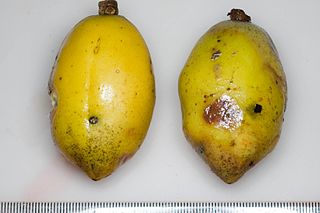
Glycydendron is a genus of plants, under the family Euphorbiaceae first described as a genus in 1922. It is native to South America.
- Glycydendron amazonicumDucke - French Guinea, Suriname, Guyana, Ecuador, Peru, Bolivia, northwestern Brazil, possibly Colombia
- Glycydendron espiritosantenseKuhlm, - State of Espirito Santo in Brazil

Abolboda is a genus of flowering plants, traditionally and nowadays assigned to family Xyridaceae. It is native to South America and to the island of Trinidad, generally on marshy savanna.

Oxypetalum is a genus of flowering plants in the family Apocynaceae, first described with this name in 1810. The genus is native to South America.
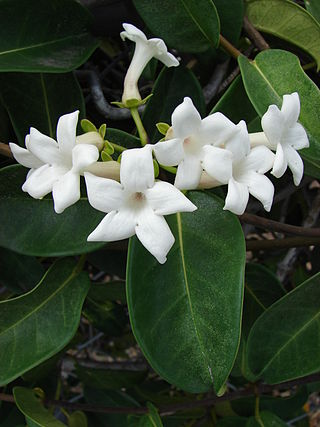
Marsdenia is a genus of plants in the family Apocynaceae first described as a genus in 1810. It is named in honor of the plant collector and Secretary of the Admiralty, William Marsden. The plants are native to tropical regions in Asia, Africa, Australia, and the Americas.
Eurydochus is a genus of flowering plants in the family Asteraceae.

Gochnatia polymorpha, the candeia or cambará, is a South American tree species in the family Asteraceae, native to Brazil, Bolivia, and Paraguay.
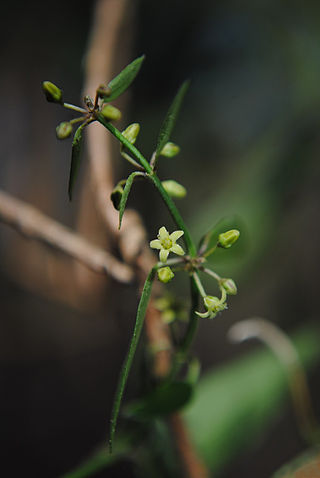
Orthosia is a genus of plants in the family Apocynaceae, first described as a genus in 1844.
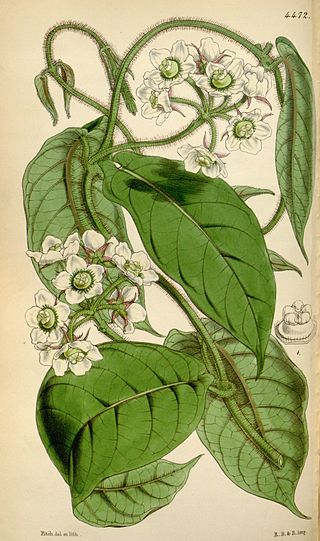
Fischeria is a plant genus in the family Apocynaceae, first described as a genus in 1813. It is native to South America, Central America, southern Mexico, and the West Indies.
Tassadia is a genus of plants in the family Apocynaceae, first described as a genus in 1844. It is native primarily to South America, with one species extending north into Central America, S Mexico, and Trinidad.

Barjonia is a genus of flowering plants in the family Apocynaceae, first described as a genus in 1844. They are native to South America.
Minaria is a genus of flowering plants in the family Apocynaceae, first described as a genus in 2006. They are native to Brazil and Bolivia in South America.
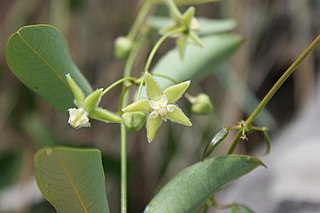
Blepharodon is a genus of plant in the family Apocynaceae, first described as a genus in 1844. They are native primarily to South America, with one species extending into Central America and Mexico.

Macroditassa is a genus of plant in family Apocynaceae, first described as a genus in 1927. It is native to South America.
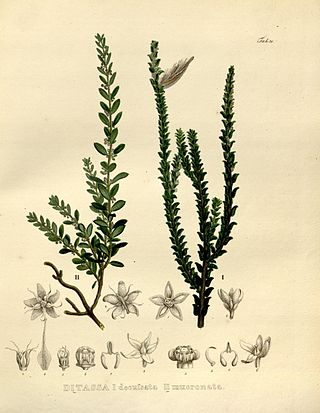
Ditassa is a genus of plant in the family Apocynaceae, first described as a genus in 1810. It is native to South America.
Petalostelma is a genus of flowering plants in the family Apocynaceae, first described as a genus in 1885. They are native to South America.
Melinia is a genus of plants in the family Apocynaceae, first described as a genus in 1835. It was initially given the name Brachylepis, but this turned out to be an illegitimate homonym, meaning that someone else had already used the name for a different plant. Melinia is native to South America.
- Melinia eichleri(E. Fourn.) K. Schum. - Brazil
- Melinia peruvianaSchltr. - Ayacucho in Peru
- Melinia volcanenseKrapov. & S. Cáceres - Jujuy Province in NW Argentina

Peplonia is a group of plants in the family Apocynaceae first described as a genus in 1844. The entire genus is endemic to Brazil.
- Peplonia asteria(Vell.) Fontella & E.A. Schwarz - Brazil
- Peplonia axillaris(Vell.) Fontella & Rapini - Brazil
- Peplonia bradeana(Fontella & E.A. Schwarz) Fontella & Rapini - Espírito Santo
- Peplonia hatschbachii(Fontella & de Lamare) Fontella & Rapini - Paraná
- Peplonia hilarianaE.Fourn. - Brazil
- Peplonia nitidaDecne. - Brazil
- Peplonia organensis(E.Fourn.) Fontella & Rapini - Brazil
- Peplonia riedelii(E.Fourn.) Fontella & Rapini - Rio de Janeiro

Schiekia is a genus of herbs in the family Haemodoraceae, first described as a genus in 1957. It contains only one recognized species, Schiekia orinocensis, native to South America. This plant grasped the minds of many scientists who tried fruitlessly to discover its purpose in the natural order.
Hemipogon is a genus of flowering plants in the family Apocynaceae, first described as a genus in 1844. It is native to South America.

Chromolaena ivifolia called ivy-leaf false thoroughwort, or ivyleaf thoroughwort, is a species of flowering shrub in the family Asteraceae. It is native to North America and South America, from the south-eastern United States to Argentina.













